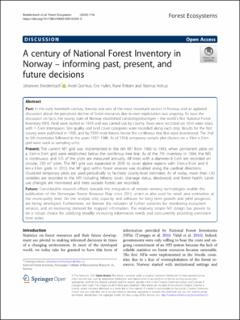| dc.description.abstract | Past: In the early twentieth century, forestry was one of the most important sectors in Norway and an agitated discussion about the perceived decline of forest resources due to over-exploitation was ongoing. To base the discussion on facts, the young state of Norway established Landsskogtakseringen – the world’s first National Forest Inventory (NFI). Field work started in 1919 and was carried out by county. Trees were recorded on 10 m wide strips with 1–5 km interspaces. Site quality and land cover categories were recorded along each strip. Results for the first county were published in 1920, and by 1930 most forests below the coniferous tree line were inventoried. The 2nd to 5th inventories followed in the years 1937–1986. As of 1954, temporary sample plot clusters on a 3 km × 3 km grid were used as sampling units. Present: The current NFI grid was implemented in the 6th NFI from 1986 to 1993, when permanent plots on a 3 km × 3 km grid were established below the coniferous tree line. As of the 7th inventory in 1994, the NFI is continuous, and 1/5 of the plots are measured annually. All trees with a diameter ≥ 5 cm are recorded on circular, 250 m2 plots. The NFI grid was expanded in 2005 to cover alpine regions with 3 km × 9 km and 9 km × 9 km grids. In 2012, the NFI grid within forest reserves was doubled along the cardinal directions. Clustered temporary plots are used periodically to facilitate county-level estimates. As of today, more than 120 variables are recorded in the NFI including bilberry cover, drainage status, deadwood, and forest health. Landuse changes are monitored and trees outside forests are recorded. Future: Considerable research efforts towards the integration of remote sensing technologies enable the publication of the Norwegian Forest Resource Map since 2015, which is also used for small area estimation at the municipality level. On the analysis side, capacity and software for long term growth and yield prognosis are being developed. Furthermore, we foresee the inclusion of further variables for monitoring ecosystem services, and an increasing demand for mapped information. The relatively simple NFI design has proven to be a robust choice for satisfying steadily increasing information needs and concurrently providing consistent time series. | en_US |

